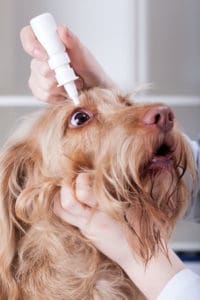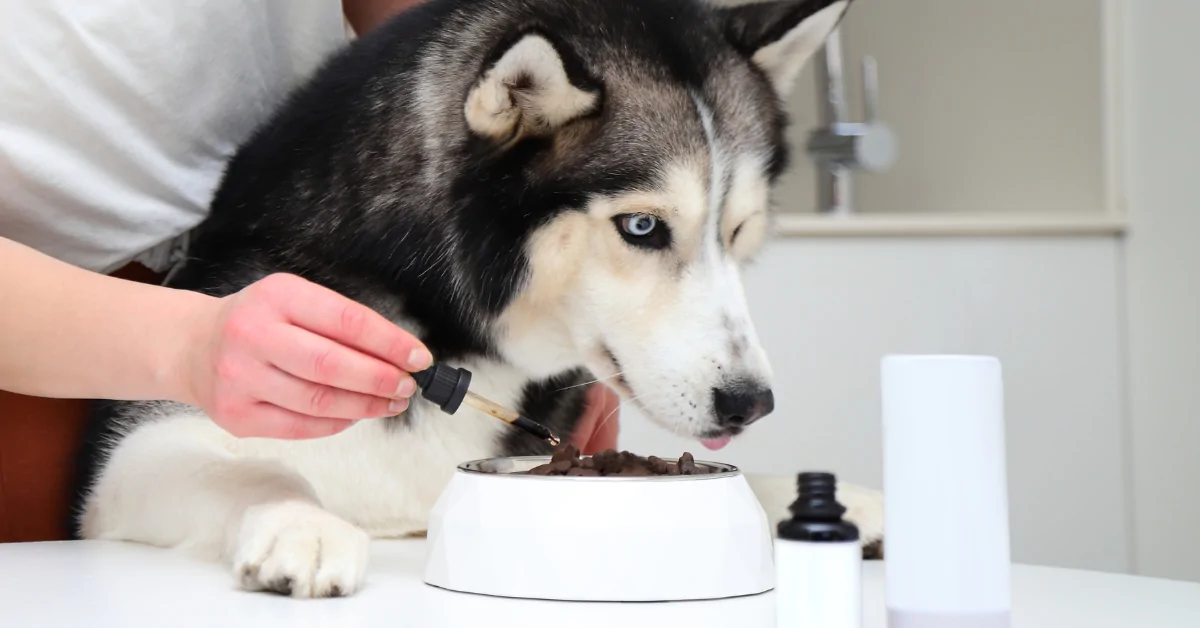
There are numerous things that cause conjunctivitis in dogs.
Pink eye, or “conjunctivitis,” as it is medically referred to, is an eye condition that affects the conjunctiva and can be quite painful. The condition is a result of the conjunctiva becoming inflamed. The conjunctiva is the thin and transparent tissue that lines the inside part of the eyelid and lies over the white part of the eye. A lot of people, especially dog owners, wonder if canines can get pink eye. The answer is YES; they can!
There are several reasons why a dog’s eye(s) can become infected. Some of them include allergies, parasites, a foreign body entering the eye, bacteria, or even a virus. Since there are so many ways your dog’s eye(s) can become infected, there are several options to treat pink eye in dogs.
Dog Pink Eye Signs
As mentioned earlier, conjunctivitis, in both canines and humans, is when the conjunctiva becomes inflamed or irritated. The most common indicator of the condition is redness in one or both eyes. This is why it is called pinkeye. However, a canine’s eye is different from that of a human, in that the conjunctiva in dogs is a bit hidden. As a result, the telltale sign, which is redness of the eye, can easily be missed despite spending hours staring into your pup’s eyes. Nevertheless, several symptoms will let you know that your dog is suffering from conjunctivitis.
Dog Conjunctivitis Symptoms
Apart from bloodshot eyes or redness, other symptoms to look out for include:
- Watery eyes
- Crustiness
- Puffy eyelids
- Unusual discharge from the eye (it can either be clear or might contain pus or mucous)
- Squinting or excessive blinking
- Swelling around the eye
- Eyelids sticking together
If you see your pup consistently fussing with his eye(s), then consider taking him or her to the vet for a quick checkup. If you think that your dog has pinkeye but aren’t sure, make a point of taking him or her to a vet for a complete eye exam. That way, it will be easier to tell if he has conjunctivitis or any other eye disease. As a dog owner, there is one symptom that should always warrant a visit to the vet – and that is any behavior that is unusual of your dog, especially when it comes to his eyes. You know how your pup behaves when he is healthy and in good moods, so you should not ignore any strange behavior. It is a sign that something is not right with him.
What Causes Conjunctivitis in Dogs?
Conjunctivitis in dogs can be as a result of many things including:
- Allergies
- Injury to the eye
- Parasites
- A virus
- Cancer
- Bacteria like Streptococcus pneumoniae, Pseudomonas aeruginosa, Haemophilus influenzae, or Staphylococcus aureus
- KCS (Keratoconjunctivitis sicca), commonly referred to as canine dry eye. Just like our eyes, this problem impairs a pup’s natural ability to make tears, which are needed to keep the eyes lubricated.
Is Dog Pink Eye Contagious?
One of the most commonly asked questions concerning pink eye and dogs is if the condition is contagious and if a human can contract it from their canine friends and vice versa. After all, the condition is extremely infectious. While there’s a lot of debate concerning these queries, like with most diseases, prevention is better than cure.
Dog conjunctivitis can either be non-contagious or contagious. The contagious kind is typically caused by a virus, parasite, or bacteria, while eye injury or allergies cause the non-contagious type. It is worth noting the infectious version of conjunctivitis is quite rare in dogs. Nevertheless, it is still highly contagious and can be spread through contact with an infected eye or discharge from an infected eye. Even less clear is if the disease is specific to certain dog species.
Can You Get Pink Eye From A Dog?
Can dogs contract pinkeye from humans? According to some veterinarians, humans can transmit pinkeye to dogs. As such, if you are currently suffering from conjunctivitis, make sure you keep your infected eye or its discharge away from your pet and wash your hands regularly! However, they aren’t that sure if humans can contract the condition from dogs, which means that they do not see “eye to eye” on this matter. When it comes to the transfer of pink eye from dog to dog, it is believed that the condition (especially if it caused by viruses, bacteria, and such) is highly contagious. Dogs, just like humans, spread the disease when they come into contact with eye secretions containing the pinkeye-causing virus or bacteria.
Routine Grooming and Care Can Help Keep Eye Infections at Bay
Proper grooming and care will lessen the possibility of your canine friend contracting conjunctivitis and other canine diseases. Proper care includes exercise, regular grooming, a good diet, and routine vaccinations. Also, neutering or spaying your pup will present him or her with plenty of benefits. As a pet owner, taking up routine care coverage provided by pet insurance will help keep the costs of regular checkups low. Another habit you should consider taking up is washing your pup’s face regularly to remove things that might lead to infections. Always make sure that you wash your hands after coming into contact with your pup’s food, water bowl, toys, and face.
Bacterial Versus Vital Pink Eye
Just like human conjunctivitis, bacterial pink eye in dogs can be hard to prevent, considering that bacteria are everywhere, and our eyes are bacteria magnets. Always make sure that the area around your pup’s eyes is clean. Also, make sure that you always remove any crusting around or discharge from his or her eyes. Most canines will have some crusting or discharge, so pay close attention to how your pup’s body works and be on the lookout for any unusual discharge. You should also check to see if the color of your dog’s discharge has a different color from the normal discharge or if the discharge is more than usual.

The best protection against dog eye infections is ensuring that your pup stays healthy.
If your pup’s conjunctivitis is as a result of a bacterial infection, treatment will most likely include an antibiotic ointment or eye drops prescribed by his or her veterinarian. Administering your dog any type of medication, especially eye drops, can be quite challenging. To have an easier time administering eye drops to your dog, seek advice and tips from your vet. Also, remember to discuss treatment options since your vet can identify the best medication for your pup. Most antibiotic medicines can be administered in various forms, including pills, eye drops, and ointments.
Just like bacterial conjunctivitis, viral pink eye can be hard to prevent and could be the result of a respiratory infection or cold. The best protection against eye infections caused by viruses is ensuring that your pup stays healthy. Exercise and a proper diet will ensure that your pup’s natural immune, which is essential to their wellbeing, remains strong. However, if diagnosed with the condition, your dog’s treatment will most likely involve the use of steroid eye drops and, in some cases, artificial tears to help keep his or her eyes clear of crusting or discharge. These medications will also go a long way in easing his or her discomfort as they kick in.
Dog Conjunctivitis Treatment
Your vet will determine your dog’s conjunctivitis by how he or she developed the problem. If your vet prescribes eye drops, there are a couple of ways you can administer the medicine correctly and safely.
- Start by cleaning the area around your pup’s eyes.
- With a firm grip, hold your dog close to your body to restrict movement. You might need some help restraining him. Someone familiar, like a friend or family member, is ideal. Proper restraint shouldn’t harm your pup; in fact, it keeps your dog from getting injured.
- Once you have restrained your dog, wrap an arm around the shoulder and use the other arm to lift his chin up so his eyes look upwards. With that hand, gently open the infected eye by pulling the lower eyelid downwards. This will create a pouch or “shelf” below his eyeball.
- Put the prescribed number of drops into the pouch while being careful not to touch the pup’s eye with the tip of the bottle.

Always make sure that you are administering the right dosage to your dog’s eye.
Once you are done administering the drops, let your pup go. His natural blinking and eye movement will spread the medication evenly over his eye(s.) Do not forget to wash your hands before and after you have administered the drug. Stay calm throughout the entire process. Canines may react to their owner’s moods. So, remember to approach the task with the right frame of mind, and your pup will automatically follow your lead.
Well, this might require a bit of practice as both you and your dog become used to the process. Remember to ask your vet for advice and always consider your dog’s size, age, overall demeanor, and health when administering medication. Do not let the challenges administering eye medication or drops present get in the way of you providing your dog the treatment he needs. Always make sure that you are administering the right dosage, so be attentive!
Allergy-Induced Conjunctivitis in Dogs
Some dogs will develop conjunctivitis due to an allergy. Ensure that you’re taking the right steps to keep your home free of pollen, dander, mold, dust, and any other thing that can trigger allergies. Identify things that trigger allergic reactions in your dog, such as smoke, plants, grass, foods, and perfumes. Do your best to keep your pup’s eyes free of dirt, dust, or any other thing that could irritate his eyes. If your dog’s pink eye is a result of an allergy, your vet will likely prescribe an anti-inflammatory or antihistamine drug plus artificial tears and steroid drops. A cold compress could also help relieve the irritation, especially if your dog’s pink eye caused by an allergy.
Eye Injuries
If your dog’s pink eye is the result of an injury, debris, or a foreign object affecting the eye, make sure you take him to a vet for examination to ensure that there’s no damage to his cornea. Luckily medication can cure cornea injuries are quite severe and can be cured with medication; however, if the case is quite severe, surgery might be required. It’s worth noting that pink eye medication could worsen corneal injuries and could lead to blindness. It is, therefore, essential that you consult your vet before administering any eye medication.
You should never diagnose and treat your pup unless you are qualified. It is also worth noting that human medication, and that includes eye drops, is not the same as medication for canines. Never treat your pup with medicine intended for humans without consulting your vet first. Using the wrong medication could cause significant damage, pain, and even blindness.
Chronic Conjunctivitis

Chronic conjunctivitis requires diagnosis by a vet.
After the problem has been diagnosed and a treatment plan has been laid out, make sure that you follow the instructions provided by your vet to the letter. Also, do your best to make sure your dog does not scratch, paw, or rub the affected eye. Since your dog will naturally want to do this, consider using a cone to keep him from injuring himself. Chronic conjunctivitis requires additional diagnosis by a vet, especially if there’s no apparent cause for the flare-up. In order to determine what is causing the problem, you will need to do a bit of investigation. This may include recording daily information to find out what could have caused the infection. This information can help your vet identify the right treatment plan. Chronic conjunctivitis can lead to more severe problems affecting the deeper layers of your dog’s eyes. Recurring chronic pinkeye can damage other parts of your dog’s eye(s). Not to mention the discomfort your dog experiences every time a bout of pink eye sets in.
How Long Does Pink Eye Last For Dogs?
Regrettably, conjunctivitis in dogs is quite common. Furthermore, your pup might be suffering from conjunctivitis in one or both eyes; so, do not let symptoms fool you if they only appear in one eye. In most of the cases a viral infection is what often affects both of your dog’s eyes. When it only affects one eye, the cause is most likely a dry eye, an infected tear duct, or an irritation. In most cases, once treatment commences, you will see improvements within a matter of days; however, for some cases, it could take up to three weeks for your pup to recover fully. The good thing, though, is that your dog will experience some relief almost immediately after you administer medication.
Vulnerable Dog Breeds
Some dog breeds are more susceptible to contracting pink eye due to their physicality or hereditary factors. Cocker Spaniels and Poodles are congenitally predisposed to pink eye. You should test them for the condition early, even before the symptoms start to appear. Other breeds such as Pekingese and Pugs can contract pink eye due to how their faces are structured. Their facial features leave their eyes vulnerable to irritants and foreign bodies in the air. Such breeds require closer and specialized attention just to keep them from contracting conjunctivitis and other eye diseases.
Fortunately, most breeds will completely recover as long as owner diagnose and treat before the disease advances. In severe cases, dogs could have scars, permanent eye damage, and may even lose their eye(s.) Like with all pet diseases, early diagnosis and proper treatment are essential. Do not let an easily treatable condition go unchecked. If so your pup will soon, be saying “eye told you so.”
We hope you found this article helpful and if your dog ever gets any cuts, abrasions, ear infections or hot spots, we hope you keep Banixx Pet Care in mind. Go to our dog page to learn more about how to keep your dog happy and healthy!
Share this Post
Featured Post
Recent Posts

Managing the Mamas –Part 2 –The development process

Managing the Mamas: Part 1 – Preparing to Breed Your Mare

HOW MANY TOES?? Caring for the Polydactyl Cat

Do Dog Joint Supplements Actually Work?

Are Laser Pointers Bad for Cats? or, are they Purr-e Fun?



